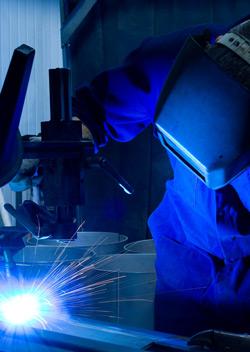- FMA
- The Fabricator
- FABTECH
- Canadian Metalworking
Welders Wanted
Already shorthanded, the Canadian welding industry braces for even more work force shortfalls as welders approach retirement age
The welding industry in Canada is at a crossroads.
Manitoba, Saskatchewan, and Alberta all are showing large shortages in the number of qualified welders. The rest of the country also is following this trend.
As technology and processes both evolve, so too must the welder.
“If there is a shortage of qualified welders now, imagine what the landscape will be like in five years,” said Dan Tadic, director of the Canadian Welding Association (CWA). “Even in this economy welders with higher skill levels are in demand.”
The CWA is the not-for-profit organization and a division of the Canadian Welding Bureau (CWB).
Traditional welding techniques such as gas metal arc welding (GMAW), gas tungsten arc welding (GTAW), and shielded metal arc welding (SMAW), always will be used, but the industry also is seeing more demand for friction stir welding, electron beam welding, underwater welding, and robotic welding.
“Welding jobs have definitely shifted over the past decade,” said Tadic. “While there is still a great need for what I would call traditional welders of carbon steel, stainless steels, and aluminum, there also is an increasing need for welding specialization.”
For example, friction stir welding, a process which Tadic says is still evolving, has traditionally been used to weld aluminum with no gas and no filler material. Now this technique is being used for the welding of carbon steel as well.
Training Tomorrow’s Welders
As the baby boom generation approaches retirement age, an employment gap will likely be created in a number of jobs. Welding is one of these.
According to the CWA, the average age of a welder in today’s work force is about 55. This means that, in the next decade or so, there will be an enormous need for skilled and experienced workers to replace them.
“We believe that it takes between five and 10 years to create a truly qualified welder,” said Tadic. “This means that we need to get people introduced to the welding industry now to avoid a dropoff, not just in numbers, but in skill level as well.”
To battle the approaching shortfall, the CWA has created a video presentation. Titled “Where Can a Career in Welding Take You?” the video is designed to promote the welding industry to high school students.
“The high school level is the ground floor of our educational process. It is often a true introduction to the variety of standard welding processes,” said Tadic. “Our goal is to keep the students that are interested in becoming welders in school after graduating high school.”
However, if the job market is the destination rather than postsecondary education, the CWB has a certification program for these students as well.
“The goal is to keep students in the classroom,” said Tadic. “This goal, in certain schools, is being realized. There are waiting lists at some schools. We need to show students that the next step from MIG, TIG, and stick could be underwater welding, electron beam welding, and laser welding.”
Where the Jobs Are
While the manufacturing industry in recent months has taken severe hits, especially in the automotive sector, there are still emerging markets that will need qualified welders. The aerospace, energy, and construction sectors are just three of these.
“Natural gas power plants, nuclear plants, and solar and wind farms all will have requirements for a large number of welders,” he said. “As these areas develop and evolve, our welders need to as well.”
This is where automated welding enters the equation.
“There is a tremendous opportunity for growth in weld automation, not only in the automotive sector but also in other areas,” said Tadic. “In the pipeline industry, for example, there is tremendous potential.”
Payback for investment in automation varies depending on the application, but it can be as little as two or three months. Typical payback is six months to one year, according to Tadic.
Automation will not eliminate the need for welders either, he added.
“You still need a welder with a good skill set and an understanding of the welding arc,” he said. “They need to understand torch-to-work distances, travel speeds, shielding gas flow, arc current, and voltage control.”
It is the goal of the CWA to help the welding industry grow and prosper in this country. CWA chapters continue to expand their reach. There are currently 12 chapters, and 10 more are scheduled to open within the next year.
“Our industry does not get a lot of headlines,” said Tadic. “Welding is a key enabling component of our economy and requires more industry support and government investment.”
For more information, visit www.cwa-acs.org.
subscribe now


Keep up to date with the latest news, events, and technology for all things metal from our pair of monthly magazines written specifically for Canadian manufacturers!
Start Your Free Subscription- Trending Articles
- Industry Events
MME Winnipeg
- April 30, 2024
- Winnipeg, ON Canada
CTMA Economic Uncertainty: Helping You Navigate Windsor Seminar
- April 30, 2024
- Windsor, ON Canada
CTMA Economic Uncertainty: Helping You Navigate Kitchener Seminar
- May 2, 2024
- Kitchener, ON Canada
Automate 2024
- May 6 - 9, 2024
- Chicago, IL
ANCA Open House
- May 7 - 8, 2024
- Wixom, MI















